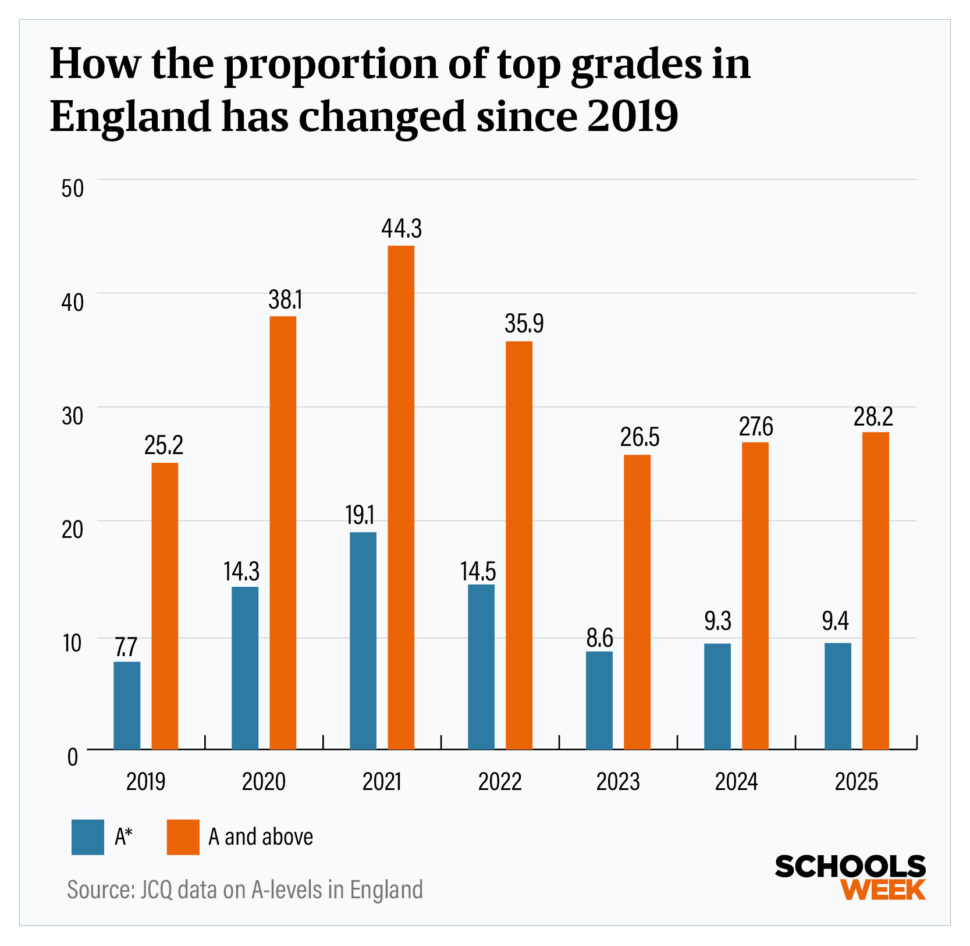The proportion of top A-level grades achieved by students in England has risen slightly again this year – with boys outscoring girls for the first time since the pandemic hit.
This year, 28.2 per cent of grades were A or above, up from 27.6 per cent last year (a 2 per cent rise). That also marks a 12 per cent rise on the 25.2 per cent in pre-pandemic 2019.
The proportion of A* grades is largely the same (9.4 per cent this year compared to 9.3 per cent in 2023). However, this is still 22 per cent up on 2019.
Meanwhile, the gap between the top and lowest attaining regions has also grown after results rose in London and fell in the north east.
‘Stronger cohort’ behind results rise
Amanda Swann, executive director for General Qualifications at Ofqual, said “any change in numbers achieving a grade is entirely due to a change in student performance, not a change in the standard expected”.
She added prior attainment suggested this year’s A-level cohort “seems to be stronger than last year’s”.
The proportion of C and above grades also rose from 76 per cent in 2024, to 77.7 per cent this year – a two per cent rise.

This year’s students also made their A-level choices in 2023 – which was the first year GCSE grading returned to normal.
“That could mean those students had a more accurate picture of their strengths to guide their choices,” Swann added.
‘Students made better choices’
“We can’t be certain, but it may be that some students who might have taken A-levels in previous years instead opted for some of the level 3 vocational options, such as applied general qualifications (for example BTECs) or T-levels.”
Despite a rise in the number of 18-year-olds this year, the number of pupils taking A-levels has remained similar. The number of A-levels taken has also fallen slightly – bucking a trend of entries rising steadily over previous years.
Meanwhile, the number of students completing T-levels this summer increased by 60 per cent up to 11,909.
In a press briefing, Ofqual chief inspector Sir Ian Bauckham refuted a claim that grade inflation was “creeping back in” to the system.
He said the grading standard “remains the same year-on-year” and said the uptick in grades was “very small”.
Bauckham refutes grade inflation claim
Outcomes at A-level also vary a little each year because the cohort choosing to take the subjects changes, he added. He described this year’s cohort as “smaller and stronger” than before.
“It may be the case that some people who may have done A-levels in previous years have done T-levels,” he added.
Ofqual said last year that results achieved in 2023 will now be the “baseline” for future grading standards.
However, despite attempts to unwind grade inflation from Covid years, results in 2023 were still higher than in 2019 – suggesting the post-pandemic grading standard is now more generous.
Regional gap widens
In England, just two regions saw top results fall this year.
The proportion of A and above grades in the north east fell to 22.9 per cent, down from 23.9 per cent in 2024. The west Midlands also saw top grades fall to 24.2 per cent, down from 24.8 per cent in 2024.
The east Midlands and the north west saw the biggest rise in top grades.
It means the gap between the north east, the lowest-attaining region, and London, the highest attaining, is now 9.2 percentage points.
This is wider than the gap between the best- and lowest-attaining regions last year, which was 8.8 percentage points.
Jill Duffy, chair of the Joint Council for Qualifications, said: “It’s for all of us and for the education sector more broadly to answer those questions that results day poses.”
Pepe Di’Iasio, general secretary of the Association of School and College Leaders, added the “big differences” reflect “socioeconomic factors which represent a massive challenge, not only for the education sector but our society as a whole”.
University rates up for poorer pupils
But the proportion of students from the poorest backgrounds getting a university place is up from 19.4 per in 2024, to 20 per cent this year.
The overall acceptance rate rose from 32.1 per cent in 2024, to 32.5 per cent this year – but has flatlined for students from the richest background.
Education secretary Bridget Phillipson said “today is a time for celebration as young people up and down the country collect their exam results”.
But she added: “Every young person should have the opportunity to achieve and thrive. This government won’t stand by and accept the entrenched inequalities that continue to blight the life chances of too many young people, especially those from white working class backgrounds who have long been overlooked.”













Your thoughts